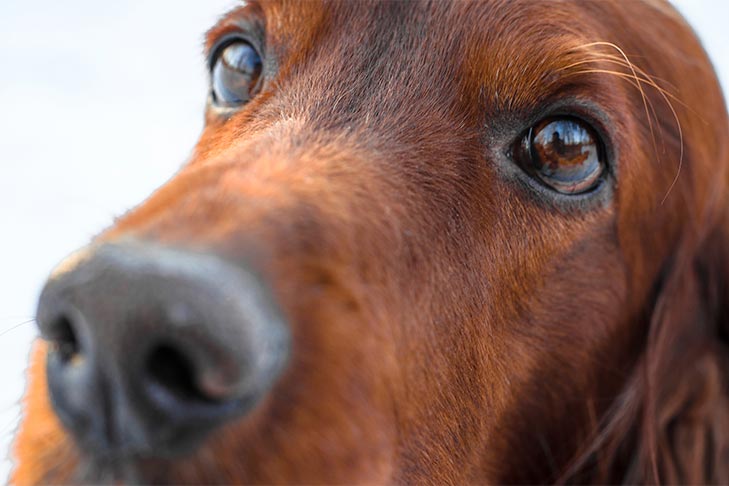It’s easy to panic when you see an abnormality on your dog’s eye. Seeing a large pink or reddish bump appears in the corner of their eye. Cherry eye is the colloquial term for this condition, but the official name is prolapse of the third eyelid gland.
In addition to the upper and lower eyelids, dogs have a third eyelid and associated gland, which helps keep the eye lubricated. When the structures around the gland weaken, it can fall from its normal position and stick out, looking somewhat like a little cherry — hence the name cherry eye.
Although cherry eye doesn’t seem to cause any pain, it can be uncomfortable for dogs or put them at risk of injury or infection from pawing at their eye. Here’s what you need to know about cherry eye, including the signs, treatment, and prognosis.
What is Cherry Eye in Dogs?
Let’s start with the anatomy of the eye. The third eyelid in dogs is called the nictitating membrane. Dr. Marta Vidal-Abarca, BVSC GPCERT (OPHTHAL) MRCVS and veterinary consultant for Catster.com, says that it moves across the eye diagonally and contains a small T-shaped cartilage. The third eyelid is mostly pink with a brown or black edge that’s visible in almost all dogs.

The third eyelid has a small tear gland, which produces approximately 30% of a dog’s tears. The remaining 70% comes from the lacrimal gland, which is located above the upper eyelid. Dr. Marnie Ford, BSC, PhD, DVM, DACVO, a board-certified veterinary ophthalmologist, says that prolapse of the third eyelid gland (cherry eye) occurs when the connective tissue around the gland weakens, leading the gland to fall and protrude out of its normal location. Often, you’ll see a pink or reddish mass in the corner of the eye.
Cherry eye can affect one or both of a dog’s eyes. Any breed is susceptible to this condition, even dogs with long noses. However, cherry eye tends to be more common in younger dogs. It is also more common in some breeds, including the Basset Hound, Beagle, Boxer, Bulldog, Cane Corso, Cocker Spaniel, Coton de Tulear, French Bulldog, Great Dane, Lhasa Apso, Maltese, Neapolitan Mastiff, Pekingese, Rottweiler, Shar Pei, and Shih Tzu.
What Causes Cherry Eye in Dogs?
The precise cause of cherry eye is unknown, and it’s hard to predict which dogs will be affected. If, for example, you change your dog’s food, or they get into a fight with another dog, that’s often unrelated, Dr. Ford says. The gland can also prolapse on its own.
“Because some breeds are more prone to it, it makes sense that there would be some genetic component,” Dr. Ford says. “But it may be multifactorial, meaning that it may not be that the ligament is loose, or the dog’s eyes are predisposed to gland prolapse.”
For example, Dr. Ford explains that the third eyelid gland may not be the problem per se, but instead, cherry eye could be a function of how the whole head of a dog is built, like in a Bulldog.
A 2022 study of more than 900,000 dogs found that dogs predisposed to cherry eye were young at diagnosis (less than 1 year old). Purebred and brachycephalic dogs had higher odds of cherry eye than mixed breed dogs and those with medium-sized skulls, respectively, suggesting a hereditary component.
Younger dogs tend to have more allergies as they’re getting used to their new environments, Dr. Ford says. If the gland is swollen from allergies, it’s likely to remain swollen. Conversely, if allergies aren’t involved, the gland may settle back into place on its own.
What to Do When the Gland is Prolapsed
A prolapsed gland means there’s more surface area being exposed to allergens. If your dog is rubbing their face, it’s likely a good idea to put a cone on them to avoid injury. It’s also critical to keep the gland lubricated. “Applying a gel-based lubricant that you can get from the local pharmacy would be perfect,” Dr. Ford says. “You don’t want it to get dried out because that makes it more difficult to fix.”

When the gland is protruding, it not only looks concerning, but it may also cause your dog discomfort. “Moreover, the gland doesn’t function properly, affecting the tear production of the affected eye,” Dr. Vidal-Abarca says. Although cherry eye differs from eye emergencies, it’s important to take your dog to the vet as soon as possible.
If it’s the first time the gland has prolapsed, the vet will massage it back into its normal location. “But if it keeps coming out and staying out despite massaging it back in, that’s when it should probably be corrected surgically,” Dr. Ford says. “That really is the treatment of choice we have as ophthalmologists.”
How is Cherry Eye in Dogs Diagnosed?
Diagnosing cherry eye is relatively straightforward, Dr. Vidal-Abarca says. Often, the owner will notice a pink or reddish mass in the corner of their dog’s eye. The condition tends to occur in dogs under 2 years old, with 75% of cases occurring in dogs less than 1 year old.
The vet will perform a full ophthalmic exam, which includes checking vision and ocular reflexes, measuring pressure in the eye, and using a fluorescent dye to inspect the eye, Dr. Vidal-Abarca explains. They’ll also measure tear production using the Schirmer tear test, which involves applying a strip of paper to the lower eyelid.
The third eyelid gland may prolapse and go back to the normal position several times before staying out permanently, Dr. Vidal-Abarca says. “The longer the gland is prolapsed, the more likely it will cause damage to the third eyelid cartilage and inflammation of the gland,” she adds.
Sometimes cherry eye can resemble another condition called cartilage eversion or third eyelid scrolling. Cartilage eversion occurs when cartilage in the third eyelid is bent, which can be congenital or acquired, Dr. Ford explains. As with cherry eye, you may see a pink bump in the corner of the eye. “Occasionally, both conditions may occur simultaneously, especially in large breed dogs,” Dr. Vidal-Abarca adds.
How Do You Treat Cherry Eye?
Historically, treatment of cherry eye involved surgical removal of the third eyelid gland. “This was later shown to increase the risk of the patient developing keratoconjunctivitis sicca or dry eye,” Dr. Vidal-Abarca says. She and Dr. Ford advise against removing the gland, given its vital role in tear production.
Now, surgery to correct cherry eye involves creating a little pocket with tissue that the gland is housed in. “We just tuck it back down and suture it in place with sutures that are all absorbable,” Dr. Ford explains. “The vast majority of those will be repaired after one correction.”

In older dogs, if the gland has been prolapsed for months or years, “it can be quite difficult to repair, and it’s not very healthy for the gland to remain out,” Dr. Ford says. When surgery is performed promptly in a younger dog, it’s almost 100% effective.
Some breeds are more prone to cherry eye recurrence, including the American Bulldog, Boxer, and Mastiff. “In approximately 5% to 10% of dogs, the gland may prolapse again, needing a second surgery,” Dr. Vidal-Abarca says. “These cases often require a different technique or a combination of methods.”
When to See a Veterinary Ophthalmologist
Dr. Ford recommends seeing your regular veterinarian first. “Most veterinarians who do this procedure do a really good job, but there are some breeds that can give you challenges, like Cocker Spaniels, Bulldogs, and Great Danes,” she says. The vet may refer your dog to a veterinary ophthalmologist in the following cases:
- The gland has been prolapsed for months or years without surgery
- The gland is not staying down despite massaging it back into place
- The gland keeps prolapsing after surgery
- The vet is not comfortable doing the surgery
- The third eyelid cartilage is bent
- The vet is less familiar with the breed
How Do You Prevent Cherry Eye in Dogs?
There aren’t any known strategies to prevent cherry eye. In some cases, environmental allergens may be a contributing factor. “If your dog shows signs of allergies affecting their eyes, consult with your veterinarian to receive prompt treatment and keep the inflammation under control,” Dr. Vidal-Abarca says.

Though only one eye may be affected initially, there’s a good chance that the gland may prolapse in the other eye. You might be wondering if it’s wise to correct the other eye as a preventive measure.
“We don’t recommend doing that because performing surgery on a third eyelid that hasn’t prolapsed can sometimes cause it to prolapse,” Dr. Ford says. Instead, she recommends keeping the affected eye lubricated and waiting a couple of weeks to see if the gland in the other eye prolapses, so you can fix both at the same time.
“The biggest thing is to not panic about these,” Dr. Ford says. “They look terrible, but they’re not emergencies.” The best thing you can do is keep the gland lubricated until you can bring your dog to the vet.






